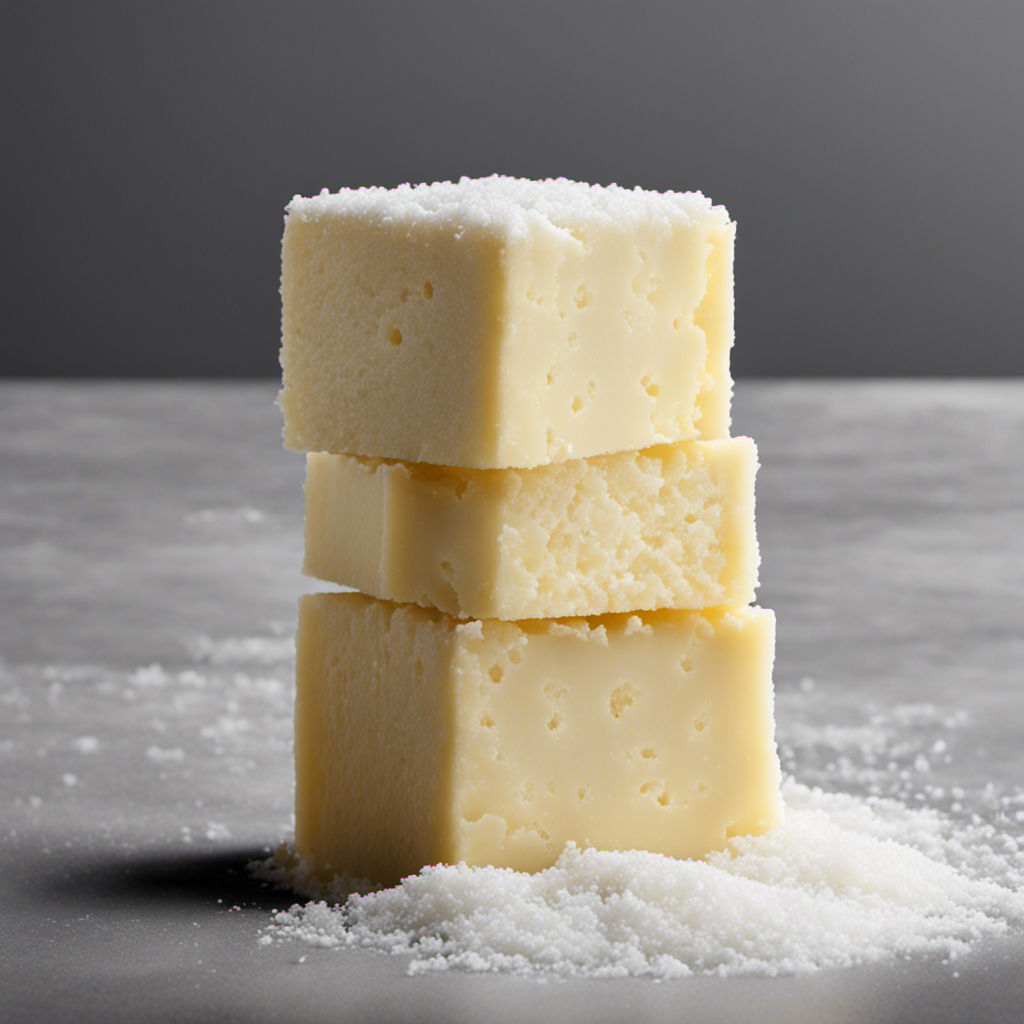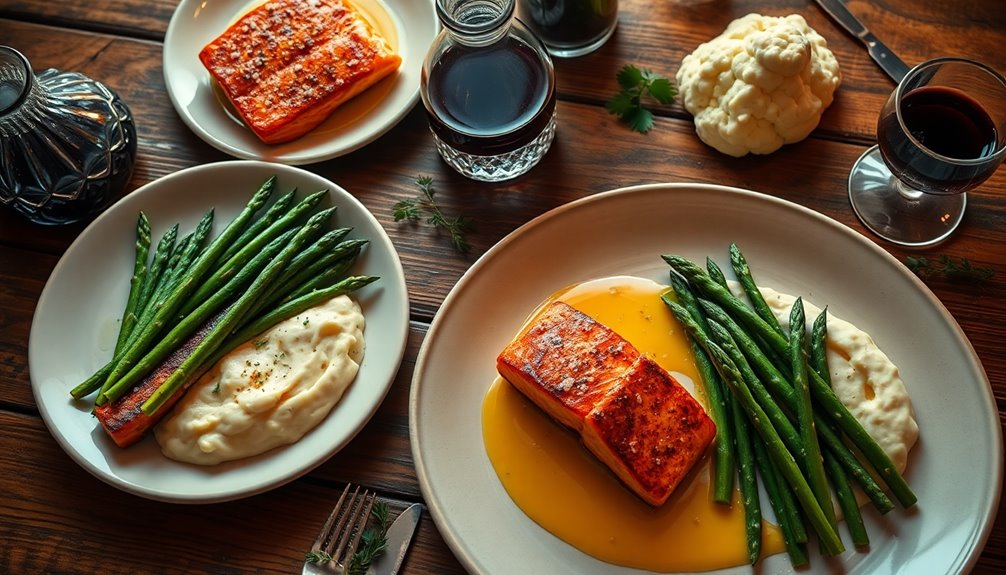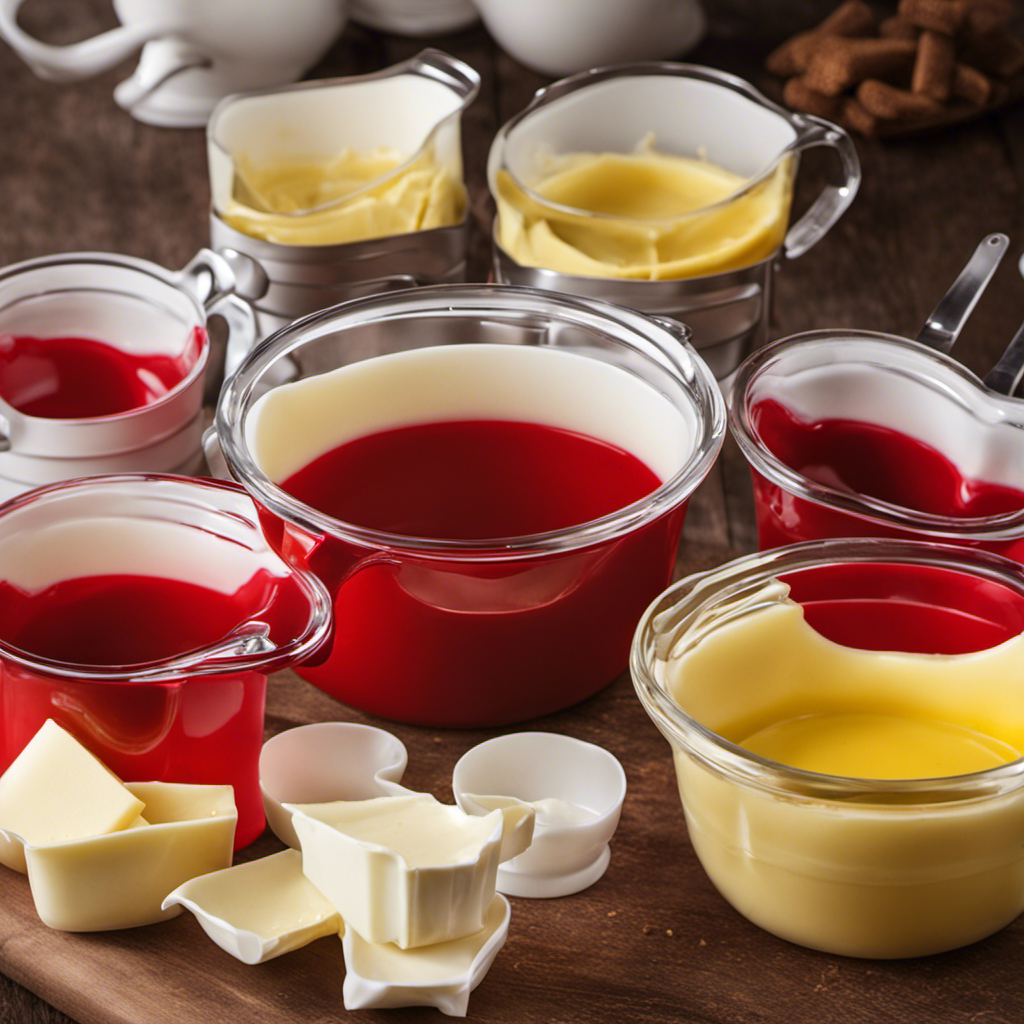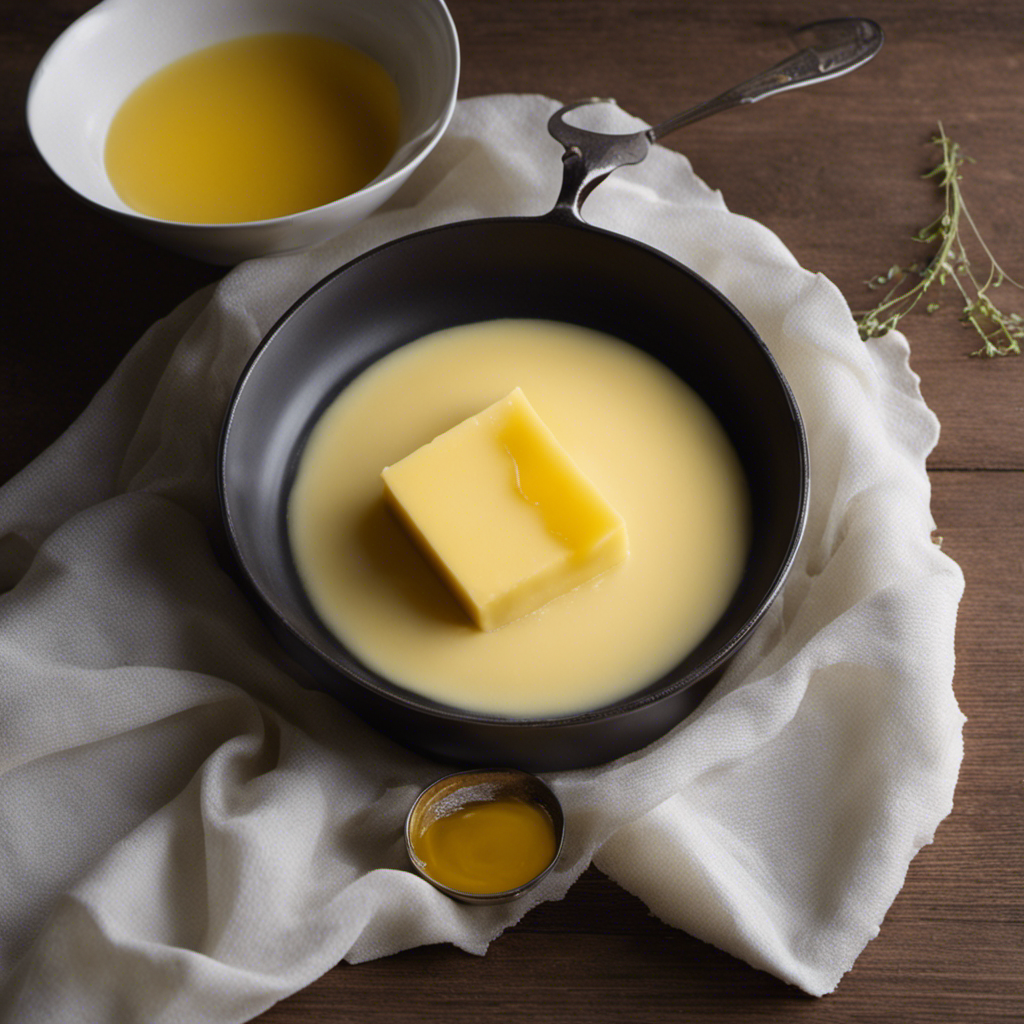Have you ever pondered on how many sticks of butter are in a pound? Allow me to share the answer with you.
In this article, I’ll break it down and simplify the process of converting butter measurements. We’ll explore the ins and outs of butter packaging, calculate butter equivalents, and provide you with a handy butter conversion chart.
So, if you’re ready to butter up your knowledge, let’s dive in and demystify this delicious dilemma.
Key Takeaways
- One pound of butter equals four sticks.
- Butter substitutions can vary depending on the recipe and desired outcome.
- Butter is often packaged in rectangular blocks or sticks, but there are also tubs or tubular containers available.
- Accurate measurements are crucial in baking and knowing the standard measurements for butter can help with conversions.
Understanding Butter Measurements
To understand butter measurements, it’s important to know how many sticks of butter equal a pound. In general, one pound of butter is equal to four sticks. Each stick of butter weighs 1/4 pound or 113 grams. This standard measurement is widely used in baking and cooking.
However, it’s also important to know that butter substitutions can vary depending on the recipe and desired outcome. Some common butter substitutes include margarine, coconut oil, and applesauce. These substitutions can have different effects on the texture and flavor of your dish, so it’s crucial to choose the right substitute for your specific needs.
With a solid understanding of butter measurements and substitutions, you can confidently navigate through various recipes and create delicious dishes.
Now let’s explore butter packaging and its role in preserving the freshness of butter.
Exploring Butter Packaging
If you’re wondering about the packaging of butter, did you know that it typically comes in rectangular blocks or sticks? This has been the traditional way of packaging butter for many years. However, there are now alternative packaging options available in the market.
Here are some interesting facts about butter packaging:
- Butter is often packaged in rectangular blocks or sticks, which makes it easy to measure and use in recipes.
- Some butter brands have started using tubs or tubular containers for packaging, which are more convenient for spreading.
- There are also butter wrappers available, which are individual portions of butter wrapped in paper or foil.
- In the past, butter was often packaged in wooden barrels or churns, which were not as practical or easy to use as the current packaging options.
The history of butter packaging shows how manufacturers have evolved to meet consumer needs and preferences. From wooden barrels to modern tubs and individual wrappers, butter packaging has come a long way.
Converting Sticks of Butter to Pounds
Did you know that a pound of butter is equivalent to four sticks? Converting butter measurements can be a bit confusing, especially when recipes call for butter in pounds but it’s sold in sticks. To help you with this, I’ve created a table below showing the conversion between sticks and pounds of butter.
| Sticks of Butter | Pounds of Butter |
|---|---|
| 1 | 0.25 |
| 2 | 0.5 |
| 3 | 0.75 |
| 4 | 1 |
| 5 | 1.25 |
As you can see, each stick of butter weighs 0.25 pounds. So if a recipe calls for 2 sticks of butter, you would need 0.5 pounds. Similarly, if a recipe calls for 5 sticks of butter, you would need 1.25 pounds. This table should make converting butter measurements a breeze, ensuring your recipes turn out just right.
Calculating Butter Equivalents
You can easily calculate the equivalent amount of butter by using the table provided. When it comes to calculating conversions, it’s important to be clear about the measurements to avoid any butter measurement confusion. Here’s a simple guide to help you:
- 1 pound of butter is equal to 4 sticks or 2 cups.
- 1 stick of butter is equal to 1/2 cup or 8 tablespoons.
- 1/2 pound of butter is equal to 2 sticks or 1 cup.
- 1/4 pound of butter is equal to 1 stick or 1/2 cup.
Standard Measurements for Butter
When it comes to baking, getting the measurements right is crucial. In this discussion, I will be talking about the standard measurements for butter, including butter pound conversion, sticks to pounds, and butter measurement equivalents.
Knowing these measurements will help you accurately follow recipes and achieve the desired results in your baking endeavors.
Butter Pound Conversion
To convert pounds to sticks of butter, all you have to do is divide the number of pounds by 0.25. This conversion is handy when following recipes that call for butter in pounds but you only have sticks of butter available.
Here are some tips to help you understand butter ratios and make the pound to stick conversion easier:
- Always remember that 1 pound of butter is equal to 4 sticks.
- If a recipe calls for 1/2 pound of butter, you will need 2 sticks.
- For 1/4 pound of butter, you will need 1 stick.
- To convert any amount of pounds to sticks, simply divide the number of pounds by 0.25.
Understanding butter ratios and using these conversion tips will ensure that you have the right amount of butter for your recipes. Happy baking!
Sticks to Pounds
If a recipe calls for sticks of butter, dividing the number of sticks by 4 will give you the equivalent weight in pounds. Understanding butter packaging and its measurement equivalents can be helpful in the kitchen. Here is a table that shows the conversion between sticks and pounds of butter:
| Sticks of Butter | Pounds of Butter |
|---|---|
| 1 | 0.25 |
| 2 | 0.5 |
| 3 | 0.75 |
For example, if a recipe calls for 2 sticks of butter, you would need 0.5 pounds of butter. This information can be useful when you need to adjust a recipe based on the amount of butter you have on hand. Remember, 1 stick of butter is equal to 0.25 pounds. So, next time you’re in the kitchen, you’ll have a better understanding of butter measurements and will be able to confidently convert between sticks and pounds.
Butter Measurement Equivalents
Understanding the conversion between sticks and pounds of butter can be helpful in the kitchen. Accuracy in butter measurement is crucial for achieving desired results in baking and cooking.
Here are some alternative butter measurements to consider:
- Cups: 1 pound of butter is equal to 2 cups.
- Ounces: 1 stick of butter is equal to 4 ounces.
- Tablespoons: 1 stick of butter is equal to 8 tablespoons.
- Grams: 1 pound of butter is equal to approximately 454 grams.
It’s important to note that different brands of butter may have slightly different weights per stick, so it’s always a good idea to check the packaging for accurate measurements.
Butter Conversion Chart
When it comes to baking, it’s important to have accurate measurements for butter. Knowing the pound equivalents of butter can be incredibly helpful in ensuring your recipes come out just right.
In this discussion, we will explore the butter pound equivalents and also delve into the importance of conducting a conversion accuracy check to guarantee precise measurements for your baking endeavors.
Butter Pound Equivalents
There’s no doubt that 1 pound of butter is equivalent to 4 sticks. When it comes to butter, understanding the weight and finding suitable substitutes can be helpful. Here are a few key points to consider:
-
Butter Weight: 1 pound of butter weighs approximately 454 grams or 16 ounces. It is important to keep this in mind when following recipes that call for specific amounts of butter.
-
Butter Substitutes: If you’re looking for alternatives to butter, there are a few options to consider. Margarine, which is made from vegetable oils, is a common substitute. Coconut oil can also be used as a dairy-free alternative. Another option is using applesauce or mashed bananas for baking purposes.
-
Healthier Choices: If you’re watching your calorie intake or trying to make healthier choices, there are low-fat or reduced-fat butter options available. These options can help reduce the overall fat content without sacrificing taste.
-
Experiment and Enjoy: Don’t be afraid to experiment with different butter substitutes in your recipes. It can lead to delicious discoveries and unique flavors.
Conversion Accuracy Check
To ensure accuracy in your conversions, it’s important to double-check the measurements when substituting butter in your recipes. Butter weight calculations can vary depending on the packaging size, so it’s crucial to compare different options. Here’s a table to help you understand the conversions:
| Butter Packaging Size | Weight (in ounces) |
|---|---|
| Stick of Butter | 4 |
| Block of Butter | 16 |
| Pound of Butter | 16 |
As you can see, a stick of butter weighs 4 ounces, while a block of butter and a pound of butter both weigh 16 ounces. This information is essential when you need to convert between different packaging sizes. By double-checking your measurements, you can ensure that your recipes turn out just right. So next time you’re substituting butter, refer back to this table to accurately convert the measurements.
How Many Sticks of Butter in a Pound
You can find out how many sticks of butter are in a pound by dividing it by 0.25. This butter weight conversion is a helpful ratio to know when following recipes or measuring ingredients.
Here are some key points about the butter pound ratio:
- A pound of butter is equivalent to 4 sticks.
- Each stick of butter typically weighs 0.25 pounds.
- Sticks of butter are commonly marked with measurements on the wrapper, making it easy to cut the desired amount.
- If a recipe calls for a specific amount of butter in pounds, you can easily convert it to sticks by dividing the poundage by 0.25.
Knowing the butter pound ratio can simplify your cooking and baking endeavors, ensuring accurate measurements and delicious results.
Butter Measurements Simplified
When baking or cooking, it’s helpful to know the measurements for butter. It can be confusing to convert butter measurements, especially when a recipe calls for pounds or sticks. To simplify butter conversions, here is a handy table that shows the equivalent measurements for butter:
| Measurement | Sticks of Butter | Cups | Grams |
|---|---|---|---|
| 1 pound | 4 sticks | 2 cups | 454 g |
| 1 stick | 0.25 pounds | 0.5 cup | 113 g |
| 1 cup | 2 sticks | 0.5 pounds | 227 g |
| 1 gram | 0.0022 pounds | 0.0044 cups | 0.0044 g |
Frequently Asked Questions
Can I Use Margarine Instead of Butter in Recipes?
Yes, you can use margarine instead of butter in recipes. Margarine is a common butter alternative that can be used in a 1:1 ratio. Just make sure to check the labels for any differences in fat content.
How Can I Soften Butter Quickly for Baking?
To quickly soften butter for baking, I zap it in the microwave for a few seconds or grate it with a cheese grater. As for alternative butter substitutes, margarine or coconut oil can be used.
What Is the Difference Between Salted and Unsalted Butter?
In my experience, when it comes to baking, using unsalted butter is better because it allows you to control the amount of salt in your recipe. Salted butter already has salt added to it.
Can I Freeze Butter for Long-Term Storage?
I freeze butter for long-term storage to preserve its freshness. It’s a great way to keep butter on hand for baking or cooking. Plus, it’s super convenient to have sticks of butter ready whenever I need them.
How Long Does Butter Last in the Refrigerator?
In the fridge, butter typically lasts around 1-3 months. Signs of spoiled butter include a rancid smell or taste, mold growth, or a change in color or texture.
Conclusion
So there you have it, folks! After diving into the world of butter measurements, exploring packaging, and calculating equivalents, we have finally reached our conclusion.
It turns out that there are four sticks of butter in a pound. Yes, you heard me right, four sticks!
So next time you’re whipping up a batch of cookies or a delicious buttercream frosting, you’ll know just how much butter to use.
Happy baking!










